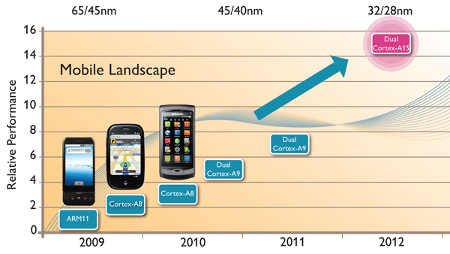Nvidia gets ARM architectural license, will integrate GPUs
Jan 6, 2011 — by LinuxDevices Staff — from the LinuxDevices Archive — 3 viewsNvidia announced it has licensed ARM's Cortex-A15 core for future-generation Tegra processors. The company also says it has obtained an ARM architectural license, which it will use to develop a CPU that “fully integrates” a GPU (graphics processing unit).
Nvidia, which announced its "Project Denver" Jan. 5 at the Consumer Electronics Show in Las Vegas, is the latest manufacturer looking to take ARM chip designs, which are dominant in the mobile phone space, into other areas. Its effort got a further boost at the show when Microsoft executives announced they are creating a upcoming "big Windows" operating system that will run on ARM-based systems.
Windows 7 currently runs on x86-based systems powered by processors from Intel and Advanced Micro Devices. However, expanding the reach of Microsoft applications to ARM-based devices would add fuel to the push to extend such ARM-designed processors into areas outside of mobile phones.
Nvidia is looking to bring the CPUs from PCs and workstations to servers and supercomputers, according to company officials. Nvidia President and CEO Jen-Hsun Huang announced Project Denver during a talk at CES.
In a blog post Jan. 5, Bill Dally, vice president and chief scientist at Nvidia, said the goal is to create CPUs based on ARM's designs, and integrate them on the same chip as the company's graphics technology. Dally — who last year wrote that Moore's Law is reaching its limit on traditional CPUs and that its only hope of continuing was to move from serial processing to parallel processing — said combining ARM-designed CPUs with GPUs (graphics processing units) is the direction the industry needs to take.
"Nvidia's project Denver will usher in a new era for computing by extending the performance range of the ARM instruction-set architecture, enabling the ARM architecture to cover a larger portion of the computing space," he wrote. "Coupled with an Nvidia GPU, it will provide the heterogeneous computing platform of the future by combining a standard architecture with awesome performance and energy efficiency."
ARM technology already is prevalent in mobile devices, from smartphones to tablets, Dally said. Project Denver will let it expand into other areas.
"Denver frees PCs, workstations and servers from the hegemony and inefficiency of the x86 architecture," Dally wrote. "Denver provides a choice."
Microsoft's decision to move bring Windows to the ARM architecture is crucial, he added.
"Microsoft's announcement that it is bringing Windows to ultra-low power processors like ARM-based CPUs provides the final ingredient needed to enable ARM-based PCs based on Denver," Dally wrote. "Along with software stacks based on Android, Symbian, and iOS, Windows for ultra-low power processors demonstrates the huge momentum behind low-power solutions that will ultimately propel the ARM architecture to dominance."
One top-tier OEM keeping an eye on developments in this area is Dell. In an interview with eWEEK, Forrest Norrod, vice president and general manager of Dell's Data Center Solutions unit, said a move to alternative instructions sets–like the ARM architecture–in the data center holds some promise, but also faces some challenges.
Bringing greater energy efficiency to servers will be attractive to businesses, Norrod said. However, it would mean moving software from x86 to another instruction set, which is no small feat for companies, he said.
"It's not a trivial expense," Norrod said.
If ARM-designed chips do gain some traction, it probably will be in systems designed for such environments as hyperscale computing rather than in mainstream servers, he said. Still, Norrod expects the effort will see some success over the next few years, primarily with hyperscale environments, where the companies own their own software, and within appliances, where the software is bundled with the hardware.
Nvidia and AMD have been aggressive in expanding the role of GPUs for general-purpose computing workloads, and AMD and Intel both at CES have launched processors that integrate the CPU and GPU on the same piece of silicon. Those chips are based on the x86 architecture.
Nvidia says it has licensed ARM's Cortex-A15 design, which ARM unveiled in September 2010. ARM officials said that Cortex-A15 will offer features — including up to 16 cores, up to 1TB of physical memory and support for virtualization — that will make it a good fit for data center servers or networking devices.

ARM's Cortex-A roadmap shows a 2012 debut for Cortex-A15 SoCs
(Click to enlarge)
The rise of virtualization and the move toward cloud computing is driving demand for low-power servers that can rapidly process transactional workloads. Nvidia isn't the only company looking to push ARM designs into servers. Calxeda — formerly known as Smooth-Stone — and Marvell also see a future for ARM-based chips in systems beyond mobile devices, including servers.
Other companies, including Tilera and Lyric Semiconductor, are building alternatives to Intel and AMD chips.
As manufacturers look to move ARM designs up the ladder and into the data center, Intel is trying to use its Atom processor platform to gain traction in the mobile device space in such systems as smartphones and tablets.
Jeffrey Burt is a writer for eWEEK.
This article was originally published on LinuxDevices.com and has been donated to the open source community by QuinStreet Inc. Please visit LinuxToday.com for up-to-date news and articles about Linux and open source.